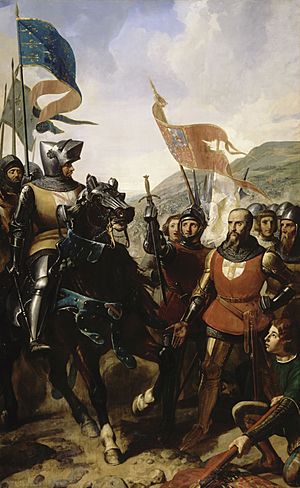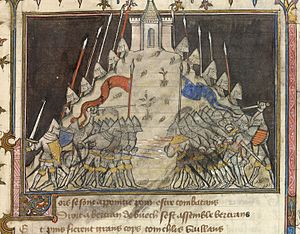Battle of Cocherel facts for kids
Quick facts for kids Battle of Cocherel |
|||||||
|---|---|---|---|---|---|---|---|
| Part of Hundred Years' War | |||||||
 Bataille de Cocherel, 16 mai 1364 (oil on canvas by Charles-Philippe Larivière, 1839) depicts Jean de Grailly surrendering to Bertrand du Guesclin |
|||||||
|
|||||||
| Belligerents | |||||||
| Commanders and leaders | |||||||
| Strength | |||||||
| 1,500–3,000 | 5,000–6,000 300 archers |
||||||
| Casualties and losses | |||||||
| Unknown | Unknown | ||||||
The Battle of Cocherel was an important fight that happened on May 16, 1364. It was part of the long Hundred Years' War between France and England. This battle was fought between the armies of Charles V of France and Charles II of Navarre, also known as Charles the Bad. They were fighting over who should rule the Duchy of Burgundy. France won this battle.
Contents
Why the Battle Happened
The French king and the Navarre kingdom had been in conflict since 1354. Navarre is a region near southern Gascony. In 1363, the French king, John II of France, was held captive in London. This made France's government weak.
Charles II of Navarre tried to use this weakness to gain more power. He wanted to take control of more land. Even though England and France had a peace treaty, Edward III of England secretly supported Navarre. He hoped to gain control of some French areas.
The peace treaty, called the Treaty of Brétigny, was signed in 1360. To avoid breaking this treaty, England did not send its official army. Instead, they used groups of paid soldiers called routiers or mercenaries. These routiers fought for Navarre, but they were not officially part of the English army.
Who Fought in the Battle
The French Army
The French forces were led by a famous knight named Bertrand du Guesclin. He was a very skilled military leader. The highest-ranking noble with the French army was Jean, Count of Auxerre.
The French army had knights and soldiers from many different parts of France. These included people from Burgundy, Brittany, Picardy, Paris, and Gascony.
The forces fighting for Navarre were led by a Gascon chief. His name was Jean de Grailly, Captal de Buch. This army was quite large. It had about 800 to 900 knights. There were also 4,000 to 5,000 other soldiers. These soldiers came from Normandy, Gascony, and England.
A very important part of this army was 300 English archers. These archers were known for their powerful longbows. An English knight named Sir John Jouel was one of the most experienced leaders. He commanded the first group of English soldiers. The Captal de Buch led the second group. Most of the English and Gascon soldiers were routiers. These were mercenary companies who had been fighting in Brittany and Western France.
The Battle Begins
The Navarre army set up their forces in three main groups. They chose a strong defensive position on a hill. Their archers were placed in wedge shapes along the front. This was a common tactic for English armies. In the past, this setup would cut down any enemy army that tried to attack them head-on.
However, Bertrand du Guesclin had a clever plan. He attacked the Navarre army, but then he pretended to retreat. This trick worked! Sir John Jouel and his group thought the French were running away. They left their strong position on the hill to chase after them. The Captal de Buch and his group followed them down the hill.
How France Won
As the Navarre forces came down the hill, du Guesclin's plan unfolded. He had kept a group of his soldiers hidden as a reserve. This reserve force suddenly attacked the Navarre army from the side. This kind of attack is called a flank attack.
This surprise attack broke the Navarre army's formation. They were no longer in their strong defensive position. The French reserve caught them off guard. This clever move by du Guesclin helped the French army win the day. The Battle of Cocherel was a clear victory for France.
See also
 In Spanish: Batalla de Cocherel para niños
In Spanish: Batalla de Cocherel para niños


